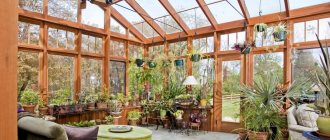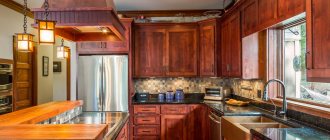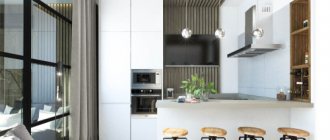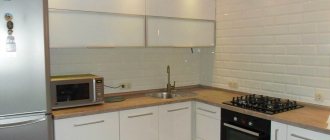If the area of your suburban area has limited space, or you want to diversify the interior of your home, apartment or office, landscape design experts recommend paying attention to a new product in modern plant decoration - vertical gardens. Such homemade designs allow you to quickly diversify the surrounding space, add individuality and beauty to it. Moreover, knowing how to make a vertical garden, you can build your own oasis of comfort and tranquility in a short period of time without any special financial costs.
What is a vertical garden?
The essence of a vertical garden is simple: plants are placed on the wall in special containers. And today landscape designers distinguish 4 types of such garden verticals:
- A picture of plants on a polymer or metal mesh, invisible under lush thickets. Visually, such a wall is one continuous living panel.
- A “carpet” garden, in which plants are planted in pockets decorated in a special textile fabric on a frame.
- A modular garden formed from pots and containers with plants combined into separate compositions.
- A garden on wooden supports, the basis for which are wooden pallets with plants growing through the transverse planks of the structure (the most striking example of such a garden is grapes on a trellis).
Any of the types of phytosystems listed above can be easily created with your own hands. But first you should know:
- What plants are suitable for each of the vertical gardens?
- and what are the features of caring for such systems?
Vertical gardening: principles, types, advantages
Vertical gardening is a very interesting, beautiful and original concept for garden design. It enlivens the space and makes it unusually picturesque.
Broadly speaking, there are three types of vertical gardening:
- Landscaping with climbing plants . The essence of the method is simple: vines entwine a wall or other support. The most ancient and simplest way. It is used to decorate the walls of various buildings and structures, as well as to decorate other structures: arches, obelisks, gazebos, etc.
- Using container flowers (vertical flower bed). Containers can be placed just like on the wall of a building, as well as on supporting pillars. Flowers can also be planted in a pipe.
- Using the “living wall” or “phytowall” technology . As a rule, this technology is produced using phytomodules - special racks with cells and a drainage system. With the help of such racks you can decorate the walls of buildings. The most difficult method, requiring certain equipment.
Vertical gardening can perform the following functions:
- To divide the garden into functional areas, for example, a recreation area, an area for doing household chores, a vegetable garden, a green room.
- For decorating the facade of a house, various buildings, buildings, structures, supporting walls, gazebos.
Advantages and benefits that vertical gardening brings:
- Decorates the surrounding space, garden, vegetable garden, buildings.
- We make the site more comfortable, beautiful and green.
- Hides shortcomings and defects of various buildings.
- Improves sound insulation (for example, from neighbors, from road noise).
- Reduce the amount of dust and make the air cleaner.
- Improves the microclimate, enriches the space with oxygen.
- Partially protects the building from the sun and, as a result, from overheating, as well as from other external influences (precipitation, wind).
- Helps divide the site into functional zones.
- Visually increases the space and makes your garden larger.
- Saves space. Ideal for garden plots with a small area.
Plants Suitable for Vertical Gardens
For phytowalls, you can take virtually any living greenery, flowering or not. And if you have to plant plants in individual containers, you don’t even have to worry about the compatibility of varieties and breeds. Is it about visual harmony?
When it comes to plant paintings or gardens on wooden supports, it makes sense to purchase Altai, mountain alpine and/or Caucasian herbs, as well as soil plants, succulents and mosses, which are typical for Japanese gardens.
Secrets of winter garden design
When organizing space, you should take into account the recommendations of professionals:
- It is best to decorate the walls in the winter garden on the loggia with natural materials, for example, stone or wood.
- Decorate your garden with a mini-pond, and if dimensions allow, then with an original fountain. Water not only harmoniously combines with plants, but is also an excellent “humidifier”.
- Large plants in solid clay pots look original, which can be interestingly placed on the floor and shelves with reliable fastening.
- A traditional decor option is the use of wicker furniture and a small frosted glass coffee table. Wicker not only looks great in greenery, but also tolerates moisture perfectly.
- A rocking chair would look great, especially if you plan to read and relax in the conservatory.
- If you don't have enough space to place flowers, buy a functional ceiling rack.
- If you want your small garden to resemble a real rural idyll, you can cover the floor with artificial grass. The lawn can be either plastic or textile.
How to care for a vertical garden?
Plants in a vertical garden are planted either in the ground or in sphagnum (moss, which absorbs a lot of water, requires little care and additionally “works” as insulation). In spring and autumn, the phyto-wall needs to be fertilized and fed with vitamins. For the winter, the plants of a vertical garden should be properly insulated. As for the flowering period, the gardener must trim off excess shoots from plants that prevent the buds from gaining strength, and also remove faded inflorescences.
Watering a vertical garden is done manually or using a drip system (which, by the way, can also be assembled with your own hands).
Where to organize a phytowall?
Any vertical garden wall is visually very attractive. And many, having seen photos of its options on the Internet, get excited about the idea of implementing something similar at their own dacha. However, experts advise that before arranging anything, you should soberly weigh your own strengths, because the installation and care of a particular living structure can be prohibitively difficult.
However, anyone can probably take care of a vertical garden. The main thing is to choose the type of system not only according to your taste, but also according to your own capabilities.
A novice summer gardener will be able to do it, for example, with the option “on the fence” or with mobile containers on a specially equipped wall. In these cases, if for some reason you don’t want to or can’t successfully start a vertical garden, you can abandon it without any problems or big losses.
An experienced plant grower who constantly lives on the site can easily master even larger forms - say, landscaping the entire artificially created vertical wall.
Which synthetic grass should you choose?
Manufacturers of rolled lawns offer a fairly wide range of products, both in texture and color. High-quality ornamental grass is visually difficult to distinguish from natural grass. It can imitate moss, grasses, and ground cover plants.
As for color solutions, the choice of artificial grass is so wide that it allows you to keep up with global trends in interior design and use fashionable shades of not only green, but also terracotta, yellow, brown and others. These can be both complex, rich colors and delicate, pastel ones: mint, bottle green, mustard, straw. The main thing is that it should immerse a person in the natural world, reduce stress levels, and bring freshness to the interior.
These artificial grass colors will harmonize well with wooden or light wicker furniture, cork flooring, floral prints on textiles, and bamboo or clay dishes. The natural style will be “supported” by accessories made from natural materials: baskets, vases, storage boxes. You can place an aquarium against a wall covered with artificial turf.
Do-it-yourself phytowall step by step
You should start with a modest-sized plant panel on the wall. This is a great way, for example, to hide an imperfect facade - the phytosystem will divert attention from problems with finishing. In addition, arranging just such a vertical garden will require a minimum of effort, money and time.
To create a living panel of plants on the facade of a house, you will need:
- stretch wire mesh over a wooden frame;
- line the mesh with sphagnum moss;
- cover the back of the frame with a wooden board;
- plant succulents through the net;
- secure the resulting structure to the selected area of the house façade.
An impromptu vertical garden can also be made from individual containers placed in a certain order on the fence or facade of the house, as well as on a specially equipped support. Any plants that feel good in the climate of the area are suitable for planting in such a garden.
The advantage of this system is the fact that in each individual container (it could be the most ordinary flower pot, or even a children’s bucket for playing in the sand), you can create soil, watering and fertilizing conditions favorable for a particular plant.
Garden on wooden supports
Here it can be used as an additional wall - to zone the territory in an original way or to create a plant environment for a gazebo. But you should approach the organization of the structure sensibly and remember: the more pots, the more time and effort it will take to care for them. Moderation is important in everything.
Not only can you grow a flower garden on a phytowall; salads, spicy herbs, and herbs will thrive there. Let the garden beds remain for vegetables.
Another example of how rationally you can use supporting vertical gardening is a wall garden by the pool. It will perfectly isolate the water and swimmers from prying eyes, and will decorate the area in an original way. True, you will constantly have to monitor the condition of the water - remove falling leaves, dry twigs, and withered buds. But you can always choose plants that fall to a minimum.
Selection of furniture and decor for the winter garden on the balcony
Good, high-quality and beautiful furniture, although it does not affect the development of ornamental plants, fully participates in the interior of the balcony.
Full range of garden furniture → in the DG Home catalog. Here you will find wicker, wooden and upholstered furniture to suit different interior styles.
Rattan wicker chairs have confidently moved into modern apartments
Furniture for the loggia should be compact and light - it will have to be moved periodically. From stationary elements, you can choose wooden seats with storage drawers. If your balcony can withstand heavy loads (up to 200-300 kg), rocking chairs, sun loungers, and chests of drawers are suitable.
Solid furniture is suitable for reinforced balcony slabs
Comfortable chairs will add coziness
Wicker furniture will become a bright, functional decor of the winter garden
Do you like the vertical layout? Put up a shelving unit.
And in Provence, and in rustic, and in modern classics
Plants themselves can become living decor - just hide unsightly decoration behind them
Suitable Products
No inventory boxes? This is also not a problem - in the Provence style, various watering cans and bottles will become decorative elements.
Old dishes in the garden are turned into useful items
Watering cans, pots, gnomes, flowers - sometimes you don’t even have to spend money on creating an atmospheric interior
In order not to overdo it with colors, choose a calm color scheme for decoration. Blooming buds will take attention to themselves, and other objects will remain in the background, which will create visual noise if color moderation is not observed. It is better to choose natural textures of wood and stone as accents.
Roses are the eternal hits of any garden, the balcony is no exception
You need to be careful with decor in Provence
The interior of the winter garden looks stylish and complete if the elements are used: flowerpots, pots, flowerpots, textiles - in the same style.
And in a real living corner, not only flowers grow - you can create a paradise microcosm in your own apartment or house with its living inhabitants: have canaries, parrots, hamsters, fish in an aquarium. For a complete composition, this is definitely a craft option; how many people have similar ones?
Recipes for Beginners
The simplest type of phytowall is considered to be a “pocket” vertical garden. Today, in any specialized gardening store you can purchase a canvas made of polymer textiles, already equipped with pocket sections for seedlings. The material is durable and perfectly holds the weight of the soil, at the same time it perfectly allows water to pass through, which means that all the necessary conditions for effective crop production are created.
All kinds of herbs (spicy, ornamental), as well as some flowers, look especially good in a “pocket” vertical garden. It will turn out very beautiful if you choose plants of different shades that harmoniously combine with each other.
Pay attention to plant characteristics
When selecting plants, it is important to pay attention to two main factors: the difficulty of growing and size. If you are a beginner gardener, try to choose unpretentious crops (chlorophytum, pike tail, aloe, tradescantia, spathiphyllum, violet, geranium, Decembrist). They are able to put up with some shortcomings in care.
If space allows, you can create a garden of plants of different heights. Such a flower garden will look voluminous and harmonious. For a small winter garden, 1-2 tall plants (1-2 m) will be enough. In addition to them, you can select several medium-sized (0.6-1 m) and low-growing specimens (up to 0.5 m).
Of course, not everyone can afford such luxury. Therefore, if the dimensions of the apartment do not allow you to “roam around,” it is better to make a flower garden of small plants. They won’t take up much space, but they will significantly change the appearance of your home.
Microcomposition by simple means
A miniature hanging composition can be built outdoors and at home if there are several “free” potted plants. The containers should be placed on several levels.
To create such a mini-garden you will need:
- 6 flat wooden planks;
- 6 round slats (also wooden);
- pieces of cable or strong ropes;
- metal hooks;
- plants in flower pots.
In each plank you first need to make 2 holes - one at each end. The diameter of such holes should correspond to the diameter of the wooden slats. Next, the slats will need to be inserted into the planks and secured securely. And then connect all three levels of suspensions with a cable or strong rope into a single, fairly stable structure.
Using metal hooks, the suspension must be secured to a wall, fence or under the ceiling of the gazebo. All that remains is to place the potted plants on the level boards and that’s it - the vertical garden composition is ready.
Important: When designing a simple phyto-hanging, you should remember that the pots at each of its levels must be the same diameter.
Vertical garden made from pallets
Before using wooden pallets to create an original vertical garden, you will need to prepare them. To do this, every second transverse board is removed from the base and then nailed again, but on the other side of the pallet. As a result, the finished structure should resemble a through double-sided staircase.
Pieces of geotextile are stretched between parallel transverse boards. They are stretched so that a slight sagging of the fabric is formed. Soil is placed in the resulting fabric pockets and plants are buried.
An alternative idea for a homemade vertical garden can be considered a composition of pallets with flower pots. In it, containers with seedlings are attached to a wooden base using semicircular metal brackets. Assembling the finished structure completely takes 2-3 hours. And such creativity is quite within the capabilities of even novice amateur gardeners.
A phytowall made of pallets with pots is suitable for installation near the facade, on the facade or on the porch. And if you choose plants with taste, it will look very attractive from early spring to late autumn.
In general, pallets open up a lot of room for creativity. For example, the bases can be painted in a dark color (mostly black, but you can choose other shades), making them almost invisible. Or, conversely, highlight it using some bright tone or color combination.
And if you use “worn” pallets that have been in intensive use, you will get a wonderful vertical garden in the shabby chic style.
How to create a vertical mini-garden quickly?
This option can be a wonderful decoration for a garden, apartment or balcony. To make a hanging vertical garden , you will need:
- 3 gutters;
- steel cable;
- plugs for gutters;
- clamps;
- hooks;
- semicircular steel rods;
- soil for plants;
- self-adhesive tape.
Making the design will not take much time.
- Make holes in the gutter for drainage, drill two holes of smaller diameter on each edge - a steel cable will be inserted into them.
- Apply self-adhesive tape to the inside.
- Pass the cable through the holes and secure with clamps. Before this, insert a steel rod into the clamp; it will securely hold the structure.
- Choose a place where the garden will be located, secure the hooks. The distance between them should be equal to the gap between the cables. Otherwise, the structure will hang unevenly.
- To make the second and third levels, steel cables are passed through several gutters.
- Place expanded clay and stones at the bottom for drainage, then pour out the soil and you can start planting.
How to expressively play with homemade vertical gardens and vegetable gardens?
In principle, any phytowall is an art object. And the impression it makes can easily be enhanced by using original containers for plants. For example, plant flowers in pots stylized as antique vases. Or assign old pots and other household utensils to the role of pots. The main thing is to securely fasten it all to the base.
By the way, using pots (any kind) turns out to be much more practical when it comes to heat-loving plants in a vertical garden. They can easily be brought into the house for the winter and stored until the next season without loss. And in the spring you can simply take it out and place it again on the phytowall. Each subsequent seasonal arrangement of a vertical garden in this case will take no more than an hour.
In which room can it be used?
Vertical gardening done with artificial grass is suitable for decorating any room. In the nursery, you can use synthetic grass of emerald color and place flowers, butterflies, and dragonflies on it.
In the living room, a phytowall will definitely attract the attention of guests. In the bedroom, made of delicate shades of green, it will promote relaxation and rest. And when you wake up and see a “corner of nature” in front of you, you can recharge yourself with positivity for the whole day.
Artificial grass can be used to decorate the walls of the entrance area or corridor. It is logical that artificial turf will also look good as an element of vertical landscaping on a balcony, loggia or veranda.
Longest vertical garden
If you want to have a large, constantly replenished vertical garden, there is no better idea than using an ordinary wooden fence with wire stretched in several parallel rows as a phytowall. The price of the issue will then be a pittance - just know, hang pots equipped with strong metal hooks on a wire base.
You can continue such a garden until “infinity,” that is, until the fence ends. However, this structure can be planted on both sides – street and yard. So such an activity can be considered truly permanent, almost endless.
A little about frame geometry
It is not at all necessary to arrange a vertical garden on a rectangular base. You can use other forms, if you have the desire and opportunity. For example, round compositions, as well as panels in the form of rhombuses and other regular and irregular geometric shapes, look great on the walls.
As for the rules for caring for vertical gardens, they do not depend in any way on the geometry of the phytostructure frames. By the way, such gardens can also have practical benefits. With their help, for example, you can create the necessary shading on a house adjoining or summer cottage, as well as on an open terrace, creating an environmentally friendly canopy. To do this, plants are launched from the phytowall onto the roof or a special canopy is made on the base.
Drawing for a serious vertical garden
A “pro” level phytowall is:
- competent choice of material;
- using really beautiful photos and drawings as a starting point;
- selection of simple but expressive forms for execution.
The most beautiful way to depict some kind of landscape with the help of plants: mountainous, flat, forest, etc. To do this, you need to choose a really bright, memorable source image. And then extremely simplify the selected picture in some graphic editor on the computer. Only the basic colors and lines should remain.
Next, you should work with the conditional sketch as follows:
- highlight volumetric elements on it (later these places will be planted with hanging flowers and/or plants with large leaves);
- break down the general background of the future painting by tones, marking the areas that will be occupied by mosses of different colors and decorative grasses of the desired shade (grasses can change their color over the course of a season, which means the living panel will turn out not only colorful, but also interactive - this must also be taken into account) .
Important: When planning a phytomodule, you should remember that the most interesting visual effect is obtained when using the simplest geometric techniques.
If you are planning a composition based on clear curves and parallel lines, you must keep in mind that such a panel will require a lot of attention to maintain. After all, any shoot that goes to the side or an unplanned flower will spoil the impression of the precisely calibrated geometry of the picture. Obviously, such a phytowall, at a minimum, will have to be trimmed regularly.
Fact: If we talk about the optimal size of shoots for a particular phytowall, it depends on the total area of the living picture. When a vertical garden occupies half a fence, you can even plant large ferns there. But on a compact panel in a small partition it is better to place only herbs, succulents and mosses.
How to organize a garden on a loggia that blooms all year round
In order for the flowers on the loggia to delight you with their colors all year round, when choosing, you should take into account their flowering period. So in the spring hyacinths and tulips are the first to bloom, in the summer pansies and lilies delight with their blooms, and autumn is the time for chrysanthemums and asters.
Plants for the winter garden
It is impossible to give clear recommendations in the form of step-by-step instructions, since the selection of plants for the winter garden depends on the existing conditions and personal preferences.
Definitely, the winter garden should be divided into conditional zones : functional and those in which the plants will be located. Moreover, these zones should be placed wisely, harmoniously and not interfere with each other.
In any case, a winter garden implies the presence of exotic plants that love a temperature of +22-25 degrees and high humidity.
Of course, less whimsical and frost-resistant specimens are unlikely to be able to get along with exotics in close proximity. It is for this case that garden zoning is needed.
Lovers of tropical climates, for example, should be placed near a source of moisture and in a place as convenient as possible for lighting.
Important! The main principle for choosing: plants for the winter garden should not be selected thoughtlessly and at the same time try to clearly imagine the desired result.
Plants for the garden can be classified approximately as follows::
- “residents” of the tropics are exotic plants;
- unpretentious inhabitants of deserts or rocks;
- fruit plants - pomegranate, citrus fruits, figs, etc.;
- edible plants (will create a unique ambiance in the kitchen).
If the living conditions of groups of plants are selected correctly, then they can be arranged - planted according to the principles of matching the color scheme and the time of flowering or fruiting.
The sizes of neighboring plants should also be taken into account , because, if placed incorrectly, they can create significant problems for each other with access to light.
We can talk about indoor plants and directly about plants for the winter garden for a very long time.
But in order to somehow summarize the information, it is worth highlighting the so-called “universal” options : dracaena, ficus, aloe, fern, cyclamen, thuja, dieffenbachia, frost-resistant palm, etc.
Distribution of plants in the winter garden on the loggia
An excess of plants will turn your loggia into an impenetrable jungle instead of a cozy corner , so the quantity needs to be measured. It is not necessary to give up large plants if the balcony space is small - it is only important to choose them correctly. Textured, expressive giants look more impressive than many small plants. The list of them is quite extensive: ficus and schefflera, crassula and euphorbia, prickly pear, agave, yucca, euonymus, dracaena and others.
The collection must include flowering plants interspersed with beautiful evergreen specimens . It is advisable to select indoor flowers of different shapes: trees, bushes, vines, hanging and creeping species.
Note! There is a basic rule that professional landscapers use when selecting plants for the winter garden. All permanent residents of a natural oasis must tolerate the same climate well.
When selecting plants, you can use an already proven option , which is usually recommended by experts. It consists of a fairly large date palm, 2-3 varieties of ficus, which may include hanging species and ficus Benjamin, which is popular among flower growers.
In addition, you can add to this set : croton covered with multi-colored foliage, elegant calathea, hardy zamioculcas and sansevieria, branched sheflera, monstera with large carved leaves. They are perfectly complemented by flowering plants: unpretentious spathiphyllum, elegant anthurium, luxurious folinopsis.
In order to properly place plants in the winter garden, it is necessary to take into account their preferences in sunlight .
If there is not enough sunlight on the loggia, then for the correct placement of flowers you can take as a basis the principle of plant growth in a tropical forest . In the lowest tier of such a forest, ferns and a variety of begonias, as well as ficus trees, grow.
The tier above is ivy and tradescantia, which should not be neglected in the winter garden, as they are famous for their unpretentiousness and attractiveness.
Exquisite folinopsis and orchids are also representatives of humid forests, but, unfortunately, without some experience in caring for these varieties, they are unlikely to delight with their luxurious flowers. But any corner of the garden will be decorated with multi-colored leaves of calathea and arrowroot.
Closer to the sun, the Chinese rose (hibiscus) will feel good, and in the most illuminated places you can place passionflower and bougainvillea, which, with proper care, will delight you with abundant flowering.
There are a huge number of plant combination options . If you set a goal, then everyone can create a garden that they like.
Vertical garden effect
Any phytowall created with your own hands requires regular maintenance. Otherwise, the expected effect will not be achieved. If you don’t have much time to care for it, it is better to plant a vertical garden with hanging and climbing plants. Then you will need to take care of them to a minimum, and the overall impression of the phytosten will be maximum.
Most often, virgin grapes and ivy are chosen for such designs. Both grow quite quickly, remain beautiful for a long time and require virtually no care. True, they have one, but rather significant, disadvantage - adventitious roots. These grow powerfully and persistently, leaving significant cracks in the plaster and brickwork. The roots of grapes and ivy can damage even the base of the wall of a building. Therefore, it is recommended to plant them only in a vertical garden created on a separate frame that is not in contact with a residential building.
The most exotic idea for connoisseurs of phytowalls is a vertical bonsai or a plant on a trellis. Any tree can be formed in this way. But, of course, fruit will look most impressive - for example, plum, apple, pear, cherry. True, the design process itself is a troublesome, painstaking task, because the trunk and branches of the plant will have to be formed from a very early age of the seedling. But the result is definitely worth it.
Plants for vertical gardening
You need to choose plants and flowers for vertical gardening based on the type of design:
- Climbing plants for walls or supports.
- Flowers and decorative foliage crops for a vertical flower bed (for pots and cache-pots) or for a phytowall.
Climbing plants
Among the climbing plants, there are many specimens suitable for vertical gardening.
Climbing perennials:
- Ivy;
- Triacum maiden grape;
- Amur grapes;
- Actinidia kolomikta;
- Tree-nose (Redbubble);
- Honeysuckle Brown;
- Honeysuckle honeysuckle;
- Clematis;
- Common hop;
- Schisandra chinensis;
- Daurian moonseed;
- Kirkazon macrofolia (Aristolochia);
- Campsis;
- Hydrangea petiolate (or creeping).
- Climbing roses.
Annual climbing plants:
- Nasturtium;
- Foreign nasturtium;
- Thunbergia;
- Morning glory (perennials are also found);
- Kobeya climbing;
- Echinocystis lobe (Echinocystis lobata, Crazy cucumber).
- Ipomoea quamoclite;
- Fire red beans;
- Dolichos;
- Eccremocarpus;
- Azarina (Maurandia);
- Cardiospermum;
Some vines attach themselves to a rough wall using aerial roots, so they do not require special support on the wall (for example, a wooden mesh). Such plants include ivy, five-leaved maiden vine, rooting campsis, and creeping hydrangea.
Container plants and flowers
The following plants are suitable (for hanging flower pots, hanging types should be used):
- Petunia;
- Begonia;
- Fuchsia;
- Lobelia;
- Dichondra;
- Bacopa;
- Diascia;
- Scaevola.
Why do I advise all summer residents and gardeners to try vertical gardening on their property? Firstly, it is very original; such a landscape design can delight even an inveterate gardener with many years of experience. Secondly, it’s just very beautiful, it looks very unusual and surprising in real life.
Phytomodule based on hydroponics
Similar equipment for a vertical garden in an apartment is a simple sealed section equipped with tiered shelves. This module also includes a water tank with built-in automatic watering and an electric timer.
To install the phytomodule, you do not need any special knowledge or skills - it is simply hung on the wall using ordinary furniture hinges, not far from the outlet.
For vertical gardening of an apartment using hydroponics, you can choose the following systems:
- standard mounted;
- or mobile (on wheels).
In addition, such modules can be single- or double-sided.
Any of the above circulation structures works using the hydroponics method. That is, plants are planted directly into shelves filled with a special substrate (nutrient mixture). Land is not needed here, because any of the known substrates contains all the necessary substances for the proper growth and development of plants.
The most commonly used substrates in vertical gardens are:
- Coconut fiber, which retains the maximum possible amount of oxygen and moisture and gives the highest performance.
- Perlite (a form of volcanic glass).
- Vermiculite, which has a number of advantages (perfectly retains elements necessary for the development of plants; protects the roots of seedlings from insects; has high moisture capacity, etc.).
- Expanded clay or clay granules that have undergone special treatment. This material easily provides plants with oxygen and is inexpensive, but it tends to accumulate substances that promote the development of harmful microorganisms.
- Moss (sphagnum), which has high moisture capacity and breathability, as well as excellent bactericidal properties.
Equipment with wick irrigation
A phytomodule with wick irrigation is a design similar to hydroponic phytomodules, but in which instead of tiers of shelves with a substrate, flower pots and flowerpots are used. Plants in such pots live in their usual soil. And wick watering guarantees their beauty, development, durability and health.
The principle of operation of such a system is extremely simple: through a special wick (cord), water penetrates into each of the installed flower pots as soon as the soil dries there. A tank in this design should be filled with water no more than 1 or 2 times a month (depending on plant varieties and indoor microclimate).
The advantages of wick irrigation are:
- mobility of pots on the frame (they can be rotated, rearranged, etc.);
- the ability to easily replace plants (for example, diseased ones with fresh ones);
- optimal level of soil moisture in each pot (plants regulate watering themselves);
- rapid growth and proper development of plants in the soil with their usual composition;
- low cost (from an economic point of view) of the chosen method.
Methods for vertical installation of grass
Preparatory work includes cleaning the wall from old plaster, old wallpaper and other decorative coatings. The next stage is primer. It must be suitable in composition for a two-component special adhesive for installing artificial grass.
The wall must be generously coated with glue. The process of gluing a rolled lawn is almost no different from gluing ordinary wallpaper. An important point: the joints of the canvases must be taped with specially designed double-sided tape.
For reliability, you can additionally secure the canvas with invisible staples.
Rules for caring for a vertical garden
As noted above, a vertical garden, no matter where it is located, cannot grow by itself, without human intervention at all. Without proper attention and compliance with certain rules, it can wither, get sick, and become overgrown. It is necessary to provide plants placed on the frame with regular watering and sufficient lighting, maintain optimal temperature and air humidity, and fight pests that interfere with their growth and development.
When working on a vertical garden in an apartment or on a country plot, it is important to follow a number of rules:
- Carry out exactly the watering that is required for this type of phytowall arrangement. In this case, the water, regardless of the irrigation system used, must be settled and at room temperature. The hardness of the liquid should also be controlled, focusing on the optimal pH level for plants: 5-6.
- It is necessary to provide lighting to living plants for at least 10-12 hours a day. This is exactly what is needed to grow and develop without problems. If necessary, you should use auxiliary lamps (by the way, they can be mounted directly into the structure).
- Be sure to regulate air humidity. It's easier to do this indoors. And in the air, the phytowall itself helps solve the problem, creating optimal natural moisture through regular, proper watering and subsequent evaporation.
- Feed plants after the incubation period according to an individual schedule using recommended preparations.
- Carry out destructive and preventive measures against pests by spraying plants with compositions specially developed for this purpose (for example, “Fitoverm” or “Fitosporin-M”).
Important: It should be remembered that fertilizing plants and treating them against pests cannot be carried out simultaneously. In order not to get confused or lost, it is worth keeping a special diary in which to write down the exact dates of the procedures performed and planned events.
- Regularly clean plant leaves from dust (wash or wipe with a damp sponge), which clogs the stomata and interferes with the leaf’s contact with light.
- Trim dry branches and pick off wilted inflorescences that spoil the appearance of a living panel.
- Infrequently, but polish the leaves using special compounds based on natural wax or olive oil.
- Regularly trim plants that need this procedure, otherwise the living composition will lose its attractiveness.
- Manage the growth of vertical garden components (pinching, thinning, rejuvenating) so that the phytowall always remains beautiful, bright, and expressive.
( 58 votes, average: 4.90 out of 5)
How to remove stains from wooden furniture?
Plastic mesh for fence: advantages and disadvantages
Related Posts
Arrangement of a loggia for a winter garden
As mentioned above, the process of arranging a flower garden on the balcony cannot be called easy. You will have to take care of high-quality repairs of the premises, and the proper placement of plants, as well as the right choice of furniture and decor.
Glazing
It is necessary to install plastic frames with double or triple glazing . With such frames, it may be enough to keep the window from the room to the balcony open to avoid the temperature dropping below zero. However, temperatures close to zero are not beneficial for flowers.
Insulation
It is necessary to insulate the entire space under and above the windows . Be sure to seal any cracks and cracks in the walls and ceilings that allow wind to leak through. And also insulate walls and fences.
Concrete fences can be insulated using a slatted wooden structure, which is filled with a heat insulator. The insulation should not accumulate moisture and should be dry. The lighter the heat insulator, the lower the thermal conductivity coefficient and its density.
Warm floor
It will create an ideal microclimate for tropical plants. Heated floor equipment has many advantages :
- the cable warms the ground, and, therefore, the roots of plants receive a sufficient amount of heat;
- heat is distributed evenly;
- Placing the cable along the walls makes it possible to avoid icing on a glass or polycarbonate roof.
This heating system is not suitable for everyone due to its high cost . In addition, it is installed even before the winter garden begins to function.
Additional radiator
The advantages of electric heaters are ease of installation, the ability to change the location of the heater, and the ability to quickly adjust the temperature.
However, such heating will be expensive if the heater is used constantly . In addition, with this heating option, the air in the room will be dry, and not all plants like this.
Ventilation
When planning a winter garden loggia, a ventilation or air conditioning system is a necessary measure . After all, not in any weather, especially in winter, you can ventilate the room by opening the window.
With natural ventilation, windows or transoms are used , which can be opened manually or automatically. Their area should be at least a quarter of the total area of the walls of the winter garden.
Note! It is also possible to equip supply and exhaust ventilation. In this option, holes are made along the perimeter of the walls through which air enters, and in the upper part there are vents for outflow.
With mechanical ventilation, air flows in naturally (through vents), and outflow occurs using fans.
Shading
You need to consider which side of the world your loggia is on. The best sun protection will be blinds :
- North side – light is scattered evenly.
- East side – in the first half of the day there is a lot of sun. Ideal for plants - no overheating, no additional ventilation needed. In the afternoon the sun is hotter, so the plants need to be shaded.
- West side - the best time is evening. The accumulated heat is retained at night. Plants will also need to be shaded from the bright rays of the sun.
- The south side is the most acceptable option. The southern sun warms the plants best. But there is a danger of getting a greenhouse effect; it also needs to be shaded.
Lighting
Plants in the winter garden must also be provided with the required level of lighting.
For additional lighting, it is recommended to use special phytolamps, which are fluorescent and energy-saving LED.
Important! Conventional incandescent lamps cannot be used to illuminate a winter garden, since their spectrum does not contain the blue rays necessary for the process of photosynthesis.
Fluorescent lamps and high-pressure sodium lamps are sensitive to voltage changes. However, fluorescent lamps burn out quickly if they are turned on and off frequently. Sodium lamps are also not suitable due to poor light transmission.
Metal halide lamps are similar to natural lighting, but have a short lifespan.
Priming
The soil is selected depending on the type of plants selected . It is better to use special soil into which the required amount of fertilizer has already been added.
Watering
For a winter garden you should choose an automatic watering system , since manual watering will take a lot of time and effort.
There are many automatic systems on the market that are equipped with adjustable irrigation modes. This is convenient, since at different times of the year plants need different amounts of moisture.
A drip irrigation system is perfect for a winter garden . Visually, such a system resembles a hose with holes.
The advantage of such a system is that moisture gets to the roots of the plants, and the dosed water supply system will prevent the formation of puddles. This system is also equipped with special sensors that determine the level of moisture in the soil.
Important! In addition to the irrigation system, it is also necessary to equip a drainage system through which excess moisture will drain away.
Humidifier
Some types of plants need to moisten not only the soil, but also the air . For this purpose, you can install a small fountain in the winter garden, which will simultaneously serve as a humidifier and decorate the garden. You can also install a fog installation or an ultrasonic humidifier.
This is an optional but useful attribute in a winter garden on a loggia . It will eliminate the need to constantly manually spray the plants.
Materials for interior finishing
When decorating a winter garden, it is preferable to use natural materials (wood and/or stone).











